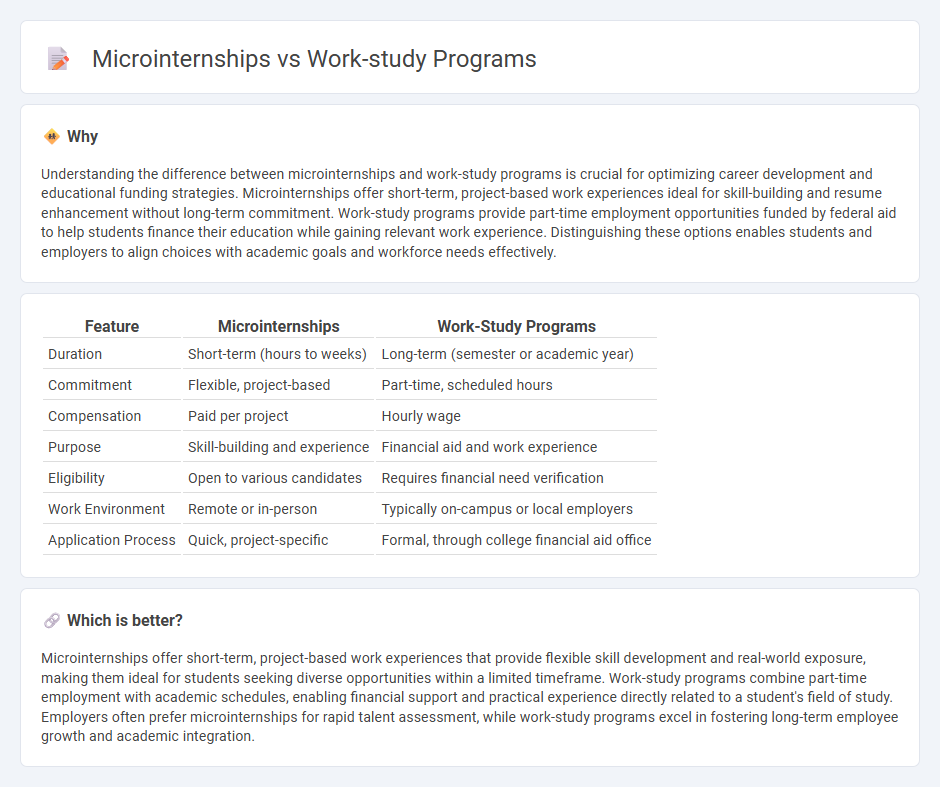
Microinternships offer short-term, project-based work experiences that enable students to develop specific skills and gain real-world exposure without long-term commitments, often accessible remotely. Work-study programs combine part-time employment with academic schedules, allowing students to earn money while gaining practical insights related to their field of study. Explore how both options can strategically enhance your career readiness and financial support during education.
Why it is important
Understanding the difference between microinternships and work-study programs is crucial for optimizing career development and educational funding strategies. Microinternships offer short-term, project-based work experiences ideal for skill-building and resume enhancement without long-term commitment. Work-study programs provide part-time employment opportunities funded by federal aid to help students finance their education while gaining relevant work experience. Distinguishing these options enables students and employers to align choices with academic goals and workforce needs effectively.
Comparison Table
| Feature | Microinternships | Work-Study Programs |
|---|---|---|
| Duration | Short-term (hours to weeks) | Long-term (semester or academic year) |
| Commitment | Flexible, project-based | Part-time, scheduled hours |
| Compensation | Paid per project | Hourly wage |
| Purpose | Skill-building and experience | Financial aid and work experience |
| Eligibility | Open to various candidates | Requires financial need verification |
| Work Environment | Remote or in-person | Typically on-campus or local employers |
| Application Process | Quick, project-specific | Formal, through college financial aid office |
Which is better?
Microinternships offer short-term, project-based work experiences that provide flexible skill development and real-world exposure, making them ideal for students seeking diverse opportunities within a limited timeframe. Work-study programs combine part-time employment with academic schedules, enabling financial support and practical experience directly related to a student's field of study. Employers often prefer microinternships for rapid talent assessment, while work-study programs excel in fostering long-term employee growth and academic integration.
Connection
Microinternships and work-study programs both offer students valuable, real-world work experiences that enhance employability and career readiness. These opportunities allow learners to apply academic knowledge in professional settings through short-term, flexible assignments or integrated academic-employment frameworks. Employers benefit from accessing motivated, skilled talent while educational institutions facilitate smoother transitions from campus to workforce.
Key Terms
Duration
Work-study programs typically span an academic term or entire school year, offering students consistent employment aligned with their studies, while microinternships are short-term, project-based engagements lasting from a few hours to several weeks. The extended duration of work-study allows for deeper skill development and stronger employer-student relationships, contrasting with the microinternships' flexibility and rapid experience gains. Explore more to understand which option best fits your career goals and schedule.
Compensation
Work-study programs typically offer hourly wages based on federal or institutional guidelines, ensuring consistent compensation for students balancing academics and employment. Microinternships often provide stipend-based or project-specific payments that vary by company and role, allowing flexible earnings tied to short-term assignments. Explore deeper insights on how compensation structures impact student engagement and financial planning in both options.
Learning Objectives
Work-study programs emphasize gaining practical skills through hands-on roles aligned with academic goals, fostering time management and professional responsibility. Microinternships concentrate on short-term, project-based experiences designed to develop specific competencies such as problem-solving, communication, and digital literacy. Explore more to understand which option best aligns with your career development needs.
Source and External Links
What Is Federal Work Study? | ACT - The Federal Work-Study program offers part-time jobs for undergraduate and graduate students with financial need, allowing them to earn money while gaining work experience related to their studies or community service, with jobs on or off campus, wages at least at minimum wage, and work hours typically up to 20 hours per week.
Work-Study - Financial Aid - Federal Work-Study is a campus-based program requiring FAFSA completion that provides part-time employment to financially needy students, with requirements including maintaining a 2.0 GPA and enrollment criteria, offering on-campus or community jobs paid biweekly with work schedules fitted around class times.
Work Study | Veterans Affairs - The Veterans Work-Study program helps eligible veterans and dependents earn money while enrolled at least three-quarters time in approved education programs, requiring participation in a VA education benefits program and fulfilling a work-study contract during the eligibility period.
 dowidth.com
dowidth.com